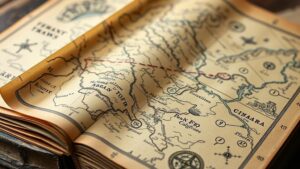Recovering Hidden Wealth in Remote Pioneer Wagon Campsites
Recovering Hidden Wealth in Remote Pioneer Wagon Campsites
The concept of recovering hidden wealth from remote pioneer wagon campsites presents a fascinating intersection of archaeology, history, and treasure hunting. As westward expansion sweeping across North America in the 19th century motivated countless individuals and families to migrate, many left behind material relics of their journey and settlement. Understanding how to identify, excavate, and interpret these sites can uncover valuable artifacts that offer insights into past economies, social structures, and daily life.
The Historical Context of Wagon Campsites
Pioneer wagon campsites served as temporary settlements where travelers would take refuge as they moved from one location to another. e camps acted as hubs for nightly rest, food preparation, and social interaction. According to the National Park Service, it is estimated that over 400,000 people traveled the Oregon Trail alone between 1840 and 1860, leaving behind evidence of their presence.
- Artifacts discovered can include cooking utensils, personal items, and discarded remnants of supplies.
- Some campsites have yielded coins and jewelry, revealing the wealth and aspirations of those who passed through.
Identifying Potential Campsites
To recover hidden wealth, the first step is identifying potential pioneer wagon campsites. Geospatial analysis using historical maps, diaries, and accounts from travelers provides critical information. Modern technologies such as Geographic Information Systems (GIS) and aerial photography can aid in locating potential sites by overlaying old maps with current landscapes.
Several key indicators can help locate these historical sites:
- Proximity to water sources, which was crucial for hydration and cooking.
- Natural clearings or sheltered areas offering protection from the elements.
- Historical landmarks or trails documented in pioneer journals and literature.
Excavation Techniques and Best Practices
Once a potential campsite is identified, it is essential to follow systematic excavation techniques to preserve and document any findings. Archaeological methods, such as stratigraphic excavation, help ensure that layers of soil are removed carefully to maintain context and association of the artifacts. Here are a few best practices:
- Use small hand tools to minimize disturbing the surrounding area.
- Conduct thorough documentation through photographing site layers, sketching layouts, and recording GPS coordinates.
- Screen sediments through mesh to capture smaller artifacts that may provide significant insights.
Case Studies: Successful Recoveries
Several noteworthy cases exemplify successful recoveries of hidden wealth from pioneer wagon campsites:
- The discovery of a stash of gold coins near a documented campsite in Wyoming, where miners left behind a valuable collection during their westward journey. This find is now housed in a local museum, informing visitors about the economic practices of the period.
- An archaeological excavation at a campsite in Iowa led to the recovery of personal items, including silver spoons and glass artifacts, giving researchers insights into daily life and trade practices.
Legal Considerations and Ethical Responsibility
Recovering artifacts from historical sites raises complex legal and ethical considerations. Most sites are protected by federal, state, or local laws, and permission is often required for excavation. Upon discovery, it is critical to report findings to proper authorities, particularly if they are on public land. Ethical responsibilities also extend to respecting the cultures and histories represented by the artifacts. Collaboration with local historians and Indigenous communities can provide greater understanding and respect for the heritage linked to these artifacts.
Conclusion: The Value Beyond Wealth
Recovering hidden wealth from remote pioneer wagon campsites transcends mere treasure hunting; it represents an opportunity to connect with the past and contribute to the understanding of early American life. By employing thorough historical research, proper excavation techniques, and ethical practices, enthusiasts and scholars alike can unearth valuable artifacts and insights that enrich narratives around migration, economy, and culture in pioneer America.
To embark on this journey, individuals should start by immersing themselves in the history of pioneer travel, studying historical resources, and gaining a solid foundation in archaeological methods and responsibilities. This effort not only brings hidden wealth to light but also preserves the stories of those who paved the way for future generations.



